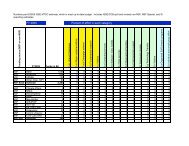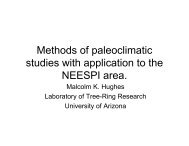The Oceanic Phosphorus Cycle
The Oceanic Phosphorus Cycle
The Oceanic Phosphorus Cycle
You also want an ePaper? Increase the reach of your titles
YUMPU automatically turns print PDFs into web optimized ePapers that Google loves.
<strong>The</strong> <strong>Oceanic</strong> <strong>Phosphorus</strong> <strong>Cycle</strong> Chemical Reviews, 2007, Vol. 107, No. 2 571<br />
Table 1. Ratios of C/N/P (by Atoms) in Plankton and Seawater<br />
by atoms<br />
source C N P<br />
Redfield (1943), plankton132 137 18 1<br />
Redfield (1934), seawater132 20 1<br />
Fleming (1940), phytoplankton132 108 15.5 1<br />
Fleming (1940), zooplankton132 103 16.5 1<br />
Fleming (1940), average a 132 106 16 1<br />
Copin-Montegut and Copin-Montegut, 183<br />
plankton and particulate matter<br />
103 16.1 1<br />
GEOSECS (nitrate/phosphate ratio ><br />
500 m), seawater<br />
14.7 1<br />
Takahashi et al., 184 organic material 103 16 1<br />
Anderson and Sarmiento, 133 organic<br />
material between 400 and 4000 m depth<br />
117 ( 14 16 ( 1 1<br />
Geider and La Roche, 139 marine<br />
particulate matter<br />
114 ( 45 16 ( 6 1<br />
a This average of phytoplankton and zooplankton is the Redfield<br />
Ratio (Redfield 1958).<br />
riverine inputs from continental sources and outputs via<br />
sediment burial but that the concentration of inorganic<br />
nitrogen is governed not only by terrestrial inputs but also<br />
by fixation by cyanobacteria, thus regulating the N/P ratio. 136<br />
Thus, when nitrogen becomes limiting, nitrogen fixers can<br />
provide a source of inorganic nitrogen to the ecosystem and,<br />
thus, phosphorus limits marine ecosystem productivity over<br />
geologic time scales. 22,23 However, nitrogen fixation by<br />
cyanobacteria can be limited by iron, because the process<br />
of nitrogen fixation has a relatively high iron demand, and<br />
iron inputs to oligotrophic regions are relatively small; thus,<br />
many regions of the world’s oceans remain nitrogenlimited.<br />
137,138 Nitrogen-fixing organisms may be limited by<br />
P, in addition to iron; therefore, at some oceanic locations P<br />
availability may limit N fixation.<br />
<strong>The</strong> Redfield N/P ratio of 16 is, however, not a universal<br />
biochemical optimum, but it rather represents an average of<br />
diverse species-specific N/P ratios which can vary from 8.2<br />
to 45.0 depending on ecological conditions. 135,139 Furthermore,<br />
the Redfield ratio varies substantially in response to<br />
changes in algal nutrient status and taxonomic affiliation and<br />
whether the P is adsorbed to the cell’s surface or is<br />
intracellular. 140 N/P ratios of the dissolved inorganic N and<br />
P in the water column (e.g., nitrate to SRP) measured over<br />
9 years at station ALOHA in the North Pacific subtropical<br />
gyre reveal complex interactions between N and P pools,<br />
suggesting that currently the gyre is in a period of net fixed<br />
N sequestration and P control of plankton growth rate. 6 On<br />
longer time scales and over large areas, the nitrogen versus<br />
phosphorus limitation in open ocean environments is determined<br />
by the balance between nitrogen fixation and denitrification<br />
such that areas that are currently P-limited could<br />
switch to nitrogen limitation in the absence of nitrogen<br />
fixation. 141,142 Recent research suggests that climate warming<br />
over the last few decades has resulted in stratification of the<br />
subtropical Pacific gyre, which favors nitrogen-fixing diazotrophs,<br />
thus increasing the nitrogen pool and pushing the<br />
system toward P limitation. 101<br />
Similarly, higher than Redfield N/P ratios, high alkaline<br />
phosphatase activities, and high rates of nitrogen fixation in<br />
the Atlantic point to phosphorus limitation or colimitation<br />
in that basin as well. 129,141 <strong>Oceanic</strong> N/P ratios in seawater in<br />
the northern hemisphere show substantial temporal fluctuations<br />
over the past five decades, suggesting that the biological<br />
part of the marine carbon cycle is not at steady state. 143<br />
However, one must keep in mind that the N/P ratios<br />
measured in bulk particulate matter or in algal cells are<br />
strongly affected by the partitioning into surface-adsorbed<br />
and intracellular phosphorus pools. Total C/N/P ratios of<br />
algae may reflect Redfield values, while in contrast the<br />
intracellular ratios consistently exceed the Redfield ratio,<br />
suggesting P deficiency, unless the surface bound P is readily<br />
available. 140 In addition, certain organisms such as the<br />
picophytoplankton Prochlorococcus and Synechococcus may<br />
have relatively low P requirements and thus the particulate<br />
organic matter they produce could differ from the Redfield<br />
Ratio. 144 <strong>The</strong> implication of the above observations is that,<br />
to properly assess phytoplankton nutrient status, knowledge<br />
of the specific phytoplankton nutritional needs and measurements<br />
of the distinct phytoplankton phosphorus pools should<br />
be assessed. 140 Ideally, this should be combined with genetic<br />
and physiological measures of limitation. 19<br />
6.2. Utilization of Organic <strong>Phosphorus</strong> Forms<br />
Organically bound P is for the most part not directly<br />
available to living organisms because it cannot be taken into<br />
the cell in this form. To be taken up, organic P must first be<br />
converted (hydrolyzed) to orthophosphate. 94 In response to<br />
P limitation, some species of phytoplankton produce enzymes<br />
that can catalyze the hydrolytic cleavage of phosphate from<br />
organic matter. Notably, alkaline phosphatases have been<br />
shown to be expressed in response to phosphate limitation<br />
in many species. 145 In addition, cell lysis releases enzymes<br />
(phosphomono- and phosphodiesterases, nucleases, nucleotidases,<br />
kinases) with greater or lesser substrate specificity<br />
that act to liberate orthophosphate from organic P compounds.<br />
146<br />
In large regions of the ocean, particularly in surface waters,<br />
much of the dissolved P is in the form of dissolved organic<br />
phosphorus (DOP), and oceanic productivity in these regions<br />
may be dependent on regeneration of bioavailable forms of<br />
P from dissolved organic matter (DOM). 100 For example, in<br />
oligotrophic surface waters, dissolved organic P (DOP) often<br />
comprises a significant portion of the dissolved P pool. 147-149<br />
Consequently, regeneration of DOP is a potentially important<br />
source of bioavailable P in these regions.<br />
<strong>The</strong> biologically available pool of phosphorus can be<br />
measured using a 32P-labeling technique developed by Karl<br />
and Bossard, 150 in which samples are incubated with 32P labeled phosphate at various light levels and the incorporation<br />
of labeled 32P into organic matter is measured. This<br />
methodology gives a measure of the P pool that is available<br />
as DIP and does not reflect processes operating on longer<br />
time scales than the incubation period of the sample (typically<br />
24 h or less). A study at station ALOHA in the Pacific<br />
oligotrophic gyre indicated that the bioavailable P exceeds<br />
the SRP pool, suggesting that the community utilizes DOP<br />
compounds for their P nutrition. 151 It has been estimated that<br />
DOP utilization can be of the same magnitude as SRP<br />
utilization in the upper water column at station ALOHA. 151<br />
<strong>Phosphorus</strong> needs and sources may differ by species. <strong>The</strong>re<br />
are systematic phylogentic differences in C/N/P ratios of<br />
marine phytoplankton. 152 Accordingly, species-specific differences<br />
in the response to nutrient enrichment can be<br />
explained by differences in the species physiology and<br />
resource competition. 153 Emiliania huxleyi blooms, for<br />
example, occur under low NO3/PO4 ratios, suggesting that,<br />
for a bloom to occur, E. huxleyi requires high phosphate<br />
concentrations relative to nitrate154 although, considering the<br />
low level of nutrients in surface water (close to detection






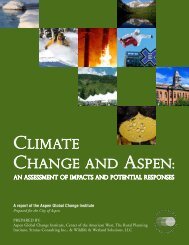

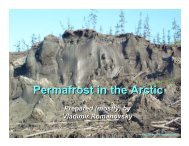
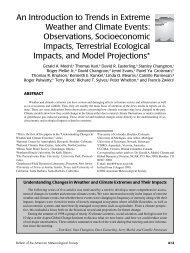
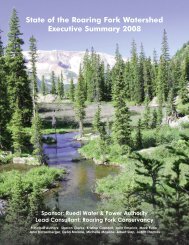
![View Powerpoint Slides [PDF]](https://img.yumpu.com/32486693/1/190x146/view-powerpoint-slides-pdf.jpg?quality=85)
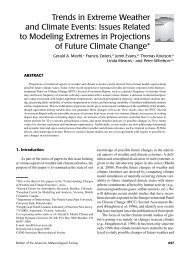


![View Powerpoint Slides [PDF]](https://img.yumpu.com/29411106/1/190x143/view-powerpoint-slides-pdf.jpg?quality=85)
